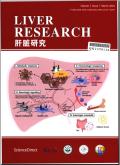New drug therapies for metabolic dysfunction-associated steatohepatitis
IF 2.1
Q2 Medicine
引用次数: 0
Abstract
The prevalence of metabolic dysfunction-associated steatotic liver disease (MASLD) has rapidly increased world-wide to 30%, with increasing of type 2 diabetes (T2D) and obesity in last two decades. The spectrum of MASLD covers from simple hepatic steatosis to the progressive metabolic dysfunction-associated steatohepatitis (MASH) with or without fibrosis, cirrhosis and hepatocellular carcinoma. The MASLD symptoms include dyslipidemia, hyperglycemia, insulin resistance and obesity, the liver manifestations of metabolic syndrome. Treatment option for MASH fibrosis is limited. Since the discovery of bile acids as the endogenous ligands of farnesoid X receptor (FXR) in early 1990, bile acid and FXR based-drug therapies have been developed and tested in clinical trials for cholestatic liver diseases and MASH fibrosis. However, many of these drugs have unwanted side-effects and moderate efficacy in improving fibrosis. The US Food and Drug Administration has not approved any of bile acid- and FXR-based drugs for MASH fibrosis. Drug therapies alternative to bile acid derivatives for MASH have been in clinical trials. Recently, resmetirom, a liver-specific- and thyroid hormone receptor beta-selective agonist has been approved for MASH fibrosis. Glucagon-like peptide-1 receptor agonists also are in clinical trials for MASH. This review covers recent development of novel drug therapies for MASH fibrosis, T2D and obesity.

代谢功能障碍相关脂肪性肝炎的新药物治疗
近二十年来,随着2型糖尿病(T2D)和肥胖症的增加,代谢功能障碍相关脂肪变性肝病(MASLD)的患病率在全球范围内迅速增加至30%。MASLD的范围包括从单纯性肝脂肪变性到进行性代谢功能障碍相关脂肪性肝炎(MASH),伴或不伴纤维化、肝硬化和肝细胞癌。MASLD的症状包括血脂异常、高血糖、胰岛素抵抗和肥胖,肝脏代谢综合征的表现。治疗MASH纤维化的选择是有限的。自1990年初发现胆汁酸作为farnesoid X受体(FXR)的内源性配体以来,以胆汁酸和FXR为基础的药物治疗已被开发出来,并在胆汁淤积性肝病和MASH纤维化的临床试验中进行了测试。然而,许多这些药物有不良的副作用,在改善纤维化方面疗效适中。美国食品和药物管理局尚未批准任何基于胆汁酸和fxr的药物治疗MASH纤维化。替代胆汁酸衍生物治疗MASH的药物疗法已进入临床试验阶段。最近,雷司替龙,一种肝脏特异性和甲状腺激素受体β选择性激动剂已被批准用于MASH纤维化。胰高血糖素样肽-1受体激动剂也在临床试验中。本文综述了治疗MASH纤维化、T2D和肥胖的新药物治疗的最新进展。
本文章由计算机程序翻译,如有差异,请以英文原文为准。
求助全文
约1分钟内获得全文
求助全文

 求助内容:
求助内容: 应助结果提醒方式:
应助结果提醒方式:


